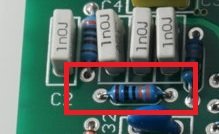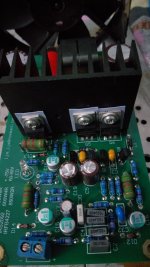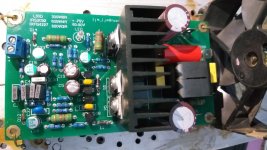I see in the picture the L30D has two driver transisors for the MOSfet´s. So it does not have the problem of other boards like the L15D, with the IRS2096 having to supply too much current from the internal voltage regulation for driving the gates? Or do I miss something?
I believe that increasing oscillating frequency to 285 khz is quite safe and can improve sound quality. Which resistors exactly need changing?
I see in the picture the L30D has two driver transisors for the MOSfet´s. So it does not have the problem of other boards like the L15D, with the IRS2096 having to supply too much current from the internal voltage regulation for driving the gates? Or do I miss something?
You can refer to iraudamp9
It uses two triodes. As a drive.
There is no problem with the L30D. It's a standard irf427 circuit.
It is not the same as l15d.
The main reason is that the voltage of power supply is different. L15d uses + - 50V
The L30D uses + - 75V.
I believe that increasing oscillating frequency to 285 khz is quite safe and can improve sound quality. Which resistors exactly need changing?
Just make this 330 ohm resistance larger.
For example, 510 ohm
Attachments
If the power supply voltage is lower than + - 75 - v.
Can try to put 2 k2 resistor in parallel 2 k2 resistance.
Get 1 k1 resistance, power is greater than 3 w.
What If I change it to total resistance of 0.9k, will it be stable and work at +/- 60V DC. And what will be the effect if k1 resistance changed from 5k1 to 3k9.
I see in the picture the L30D has two driver transisors for the MOSfet´s. So it does not have the problem of other boards like the L15D, with the IRS2096 having to supply too much current from the internal voltage regulation for driving the gates? Or do I miss something?
Its either that (too much current being sinked) or that the 2096 is not heatsinked and overheats and shorts the IRF's. I have blown 2 of these (including my woofers one time ) as they play fine, the IRF's heatsinks are not even warm, then poof... So I suspect the 2096 shorting...
What If I change it to total resistance of 0.9k, will it be stable and work at +/- 60V DC. And what will be the effect if k1 resistance changed from 5k1 to 3k9.
If someone aware of this please reply.
Thank you
These changes were implemented so the board would be stable down to 60v , mount them slightly above the board as they get hot. The k1 resistor is part of the 5.6v zener regulator that supplies 5.6v rails to the 2092 these should be 3-5 watt rated.
They are the big green ones 5.1k green brown red gold. You need to change both
Ok will change and let you know how it is working.
I have attached clear image, let me know if any other changes will be required for more quality.
Thank you
Attachments
I am not sure how relevant this is but I have one of these modules (purchased some years ago but only now being considered for use). My initial thoought was to change he silpads on the MOSFETS. They are not great for heat transfer OR insulation especially on a high power amplifier.
In you picture you can see how the area of the pads have distorted under the clamping pressure.
In you picture you can see how the area of the pads have distorted under the clamping pressure.
Sound Quality
Hi, I've recently dipped my toes into the IRS2092 Driver Chip, courtesy of a pair of L20Ds I've had knocking around for about 18 months.
I was very impressed with on bench testing.
While setting up temperature controlled fan, I had them running at 42 volts rms, 100 Hz for long periods and they performed perfectly.
I have since moved them into my system for serious listening and so far been impressed again.
Reading through the various IRS2092 threads on this site and others, there seems to be a lack of comments on the actual sound quality of these amplifiers.
Would any of you guys who have successfully assembled them and had a chance for a good listen post your impressions their of sound quality?
Mainly interested in L20, L25 and L30Ds.
Hi, I've recently dipped my toes into the IRS2092 Driver Chip, courtesy of a pair of L20Ds I've had knocking around for about 18 months.
I was very impressed with on bench testing.
While setting up temperature controlled fan, I had them running at 42 volts rms, 100 Hz for long periods and they performed perfectly.
I have since moved them into my system for serious listening and so far been impressed again.
Reading through the various IRS2092 threads on this site and others, there seems to be a lack of comments on the actual sound quality of these amplifiers.
Would any of you guys who have successfully assembled them and had a chance for a good listen post your impressions their of sound quality?
Mainly interested in L20, L25 and L30Ds.
Hi,
can I put L30D inside SEALED subwoofer box of 30l (together with linear PSU)?
How much heat does it produce?
can I put L30D inside SEALED subwoofer box of 30l (together with linear PSU)?
How much heat does it produce?
The issue is the heating of the 2092, that has no heatsink and blows up. The switchers themselves dont run very hot...
Yep. The part marked U1 is the IRS2092 chip, just like in the schematic.IRS2092 is this chip on back side? If thats true, I could glue some heatsink on it.
My supply voltage will be +-63VDC so I wont push it to the limits. But the speakers are 4 Ohm, on the other side...
The replies above are worth consideration but my worry would be that there is no air flow from the inside of the cabinet to the outsid. I am also concerned that the module cannot achieve higher power levels without additional heat sinking for the output mosfets. You will notice that most commercial designs include a hearsink of sorts. These can be large Aluminium backplate or a fined heatsink..Hi,
can I put L30D inside SEALED subwoofer box of 30l (together with linear PSU)?
How much heat does it produce?
May I ask is this circuit working properly???I found this in one of the pages here. I have NOT verified this will even work. Look at TR101 - TR104. This may be your solution to driving more than a pair of IRF4227. You could experiment with this setup. anyone care to chime in? thanks
I need to install 1 set
- Home
- Amplifiers
- Class D
- L30D IRS2092 IRFB 4227 IRAUDAMP9 MYDIY



